Sustainable Resource Allocation and Base Station Optimization Using Hybrid Deep Learning Models in 6G Wireless Networks
Abstract
1. Introduction
- To calculate accuracy, recall, precision, and F-score of the Hybrid Quantum Deep Learning model.
- To calculate power consumption upon implementing the Base Station Optimizer net model.
- To attain efficient and sustainable resource management and base station optimization using a Hybrid Quantum Deep Learning model.
2. Smart 6G Networks
2.1. AI-Assisted Network
2.2. Function of AI in Upcoming 6G Networks
- AI for Physical Layer: This involves tasks such as waveform recognition, categorization, frequency encryption and decryption, AI-assisted positioning, perception, localization, network assessment, and stabilization. AI also contributes to creating AI-friendly boundary devices.
- AI for MAC Layer RRM (Radio Resource Management): In this context, AI is employed for user clustering, proactive resource allocation, flexible power control, and interference management.
- AI for Control and Management: In the control and management layer, AI plays a pivotal role in dynamic network adaptation, active segment administration, self-management, and policy implementation, critical system enforcement, dimensioning and monitoring, and security enhancement.
- AI for Higher-Level RRM: Here, AI facilitates the creation of an AI-aided multilateral system for Radio Access Network (RAN) slice management, slice access mechanisms, segment provisioning, traffic management, and mobility administration.
3. Proposed Model
3.1. Hybrid Quantum Deep Learning Model
| Algorithm 1. 6G communication system procedure for slice prototype |
| Begin |
| Step 1: Set eMBB, URLLC, mMTC, mFile as zero trajectory of size L |
| Step 2: Initialize slice 0 |
| Step 3: The network request is initialized centered on various key categories |
| While i ≤ L |
| T1 = eMBB+L/size of(eMBB) ∗ 100 |
| T2 = mMTC+L/size of(mMTC) ∗ 100 |
| T3 = URLLC+L/size of (URLLC) ∗ 100 |
| T4 = mFileL/size of (mFileL) ∗ 100 |
| if (condition function) |
| if (high-level data speed and T1 ≤ 90%) eMBB + L = reqi |
| Else if ((reliable&& less delay) and T2 ≤ 90%) mMTC + L = reqi |
| Else if ((low-level data speed&&high-level intensity) & S3 ≤ 90%) |
| URLLC+L = reqi |
| Else mFilen = reqi |
| Else mFilen = reqi |
| End if |
| End while |
3.2. Base Station Optimizer Net Research Methodology
- Input Layer—raw data such as user data, geospatial information, network configuration parameters, and traffic patterns are taken as input for preprocessing to standardize and normalize it for the model!
- Feature Extraction Layer—Convolutional Neural Networks (CNNs) or other feature extraction techniques are used to find appropriate patterns and features from the input data.
- Optimization Layer—Recurrent Neural Networks (RNNs) or Long Short-Term Memory (LSTM) networks are utilized to capture temporal dependencies and dynamic changes in the network. Optimization algorithms are applied to find the best configuration for the placement of the base station, load balancing, and resource allocation.
- Decision Layer—fully connected neural networks are utilized for making decisions based on the extracted features and optimized parameters. It recommends power settings, frequency bands, base station placement, and other configurations.
- Training and Learning Mechanism—the model is trained using historical performance data and simulation results. It enhances continuously and adapts to changing network conditions by reinforcement learning or any other adaptive learning techniques.
- Number of features: 14, including transmitter location, receiver location, transmitter power, channel frequency, number of users, receiver power, channel noise, number of packets, packet length, load on devices, number of neighboring base stations, distance from neighboring base stations, bandwidth, and delay in the network.
- Second layer: 12 nodes with fully connected layer.
- Third layer: 8 nodes with fully connected layer.
- Fourth layer: 2 nodes with fully connected layer.
- Fifth layer: Softmax activation function. The base station is ON for output >0.5; the base station is OFF for output <0.5.
- Final layer: Classification layer providing the ultimate output based on the Softmax function’s value.
- Channel frequency = 100 THz
- Network bandwidth = 100 GHz
- Delay in the network = 5 × 10−5 s
- Transmitter power: 20 dB
- Receiver power: 3 dB
- Transmitter and receiver locations: randomly generated within a 1000 × 1000-dimensional area using MATLAB’s random function
- Channel noise: −0.5 dB
- Number of packets: 200
- Load on each device: 30 dB
- Each base station allowed 45 partner nodes
4. Results and Discussions
5. Conclusions
Author Contributions
Funding
Institutional Review Board Statement
Informed Consent Statement
Data Availability Statement
Conflicts of Interest
References
- Shi, Y.; Lian, L.; Shi, Y.; Wang, Z.; Zhou, Y.; Fu, L.; Bai, L.; Zhang, J.; Zhang, W. Machine Learning for Large-Scale Optimization in 6G Wireless Networks. IEEE Commun. Surv. Tutor. 2023, 25, 2088–2132. [Google Scholar] [CrossRef]
- Chen, W.; Johnson, S.; Tanaka, H. Advanced Resource Allocation Techniques for 6G Wireless Networks. Int. J. Wirel. Commun. 2023, 12, 78–102. [Google Scholar]
- Smith, J.; Garcia, M.; Khan, A.; Li, W. Resource Allocation and Base Station Optimization in 6G Wireless Networks. J. Adv. Wirel. Commun. 2023, 10, 123–145. [Google Scholar]
- Lin, K.; Li, Y.; Zhang, Q.; Fortino, G. AI-driven collaborative resource allocation for task execution in 6g-enabled massive iot. IEEE Internet Things J. 2021, 8, 5264–5273. [Google Scholar] [CrossRef]
- Jain, D.K.; Tyagi, S.K.K.S.; Neelakandan, S.; Prakash, M.; Natrayan, L. Metaheuristic Optimization- based Resource Allocation Technique for Cybertwin-driven 6G on IoE Environment. IEEE Trans. Ind. Inform. 2021, 18, 4884–4892. [Google Scholar] [CrossRef]
- Guan, W.; Zhang, H.; Leung, V.C.M. Customized slicing for 6G: Enforcing artificial intelligence on resource management. IEEE Netw. 2021, 35, 264–271. [Google Scholar] [CrossRef]
- Liu, K.-H.; Liao, W. Intelligent Offloading for Multi-Access Edge Computing: A New Actor-Critic Approach. In Proceedings of the ICC 2020-2020 IEEE International Conference on Communications (ICC), Dublin, Ireland, 7–11 June 2020; pp. 1–6. [Google Scholar]
- Mukherjee, A.; Goswami, P.; Khan, M.A.; Li, M.; Yang, L.; Pillai, P. Energy-efficient resource allocation strategy in massive IoT for industrial 6G applications. IEEE Internet Things J. 2020, 8, 5194–5201. [Google Scholar] [CrossRef]
- Muller, K.; Noor, A. Hybrid Quantum-Classical Algorithms for Resource Management in 6G. J. Next-Gener. Wirel. Netw. 2023, 8, 233–249. [Google Scholar]
- Nawaz, S.J. School of Creative Arts and Engineering, Staffordshire University, Stoke-on-Trent, U.K. Quantum machine learning for 6G communicationnetworks: State-of-the-art and vision for the future. IEEE Access 2019, 7, 46317–46350. [Google Scholar] [CrossRef]
- Anu, J.; Jithin, J.; Tommaso, M. Redefining wireless communication for 6G: Signal processing meets deep learning with deep unfolding. IEEE Trans. ArtifIntell 2021, 2, 528–536. [Google Scholar]
- Puspitasari, A.A.; An, T.T.; Alsharif, M.H.; Lee, B.M. Emerging Technologies for 6G Communication Networks: Machine Learning Approaches. Sensors 2023, 23, 7709. [Google Scholar] [CrossRef] [PubMed]
- Liu, Y.; Ding, J.; Liu, X. Resource allocation method for network slicing using constrained reinforcement learning. In Proceedings of the 2021 IFIP Networking Conference (IFIP Networking), Espoo and Helsinki, Finland, 21–24 June 2021; pp. 1–3. [Google Scholar]
- Suresh, K.; Alqahtani, A.; Rajasekaran, T.; Kumar, M.S.; Ranjith, V.; Kannadasan RAlqahtani, N.; Khan, A.A. Enhanced metaheuristic Algorithm-Based load balancing in a 5G cloud radio access network. Electronics 2022, 11, 3611. [Google Scholar] [CrossRef]
- Fernandez, C.; Sharma, P.; Lee, D. Deep Learning-Based Resource Allocation in Dense 6G Networks. J. Wirel. Technol. Appl. 2023, 15, 89–107. [Google Scholar]
- Sami, H.; Otrok, H.; Bentahar, J.; Mourad, A. AI- based resource provisioning of IoE services in 6G: A deep reinforcement learning approach. IEEE Trans. Netw. Serv. Manag. 2021, 18, 3527–3540. [Google Scholar] [CrossRef]
- Suyama, S.; Okuyama, T.; Kishiyama, Y.; Nagata, S.; Asai, T. A Study on Extreme Wideband 6G Radio Access Technologies for Achieving 100 Gbps Data Rate in Higher Frequency Bands. IEICE Trans. Commun. 2021, E104-B, 992–999. [Google Scholar] [CrossRef]
- Imoize, A.L.; Adedeji, O.; Tandiya, N.; Shetty, S. 6G enabled smart infrastructure for sustainable society: Opportunities, challenges, and research roadmap. Sensors 2021, 21, 1709. [Google Scholar] [CrossRef] [PubMed]
- Ivanov, D.; Mei, L. Optimization Strategies for 6G Base Stations Using Reinforcement Learning. Wirel. Netw. Commun. 2023, 19, 145–160. [Google Scholar]
- Suresh, K.; Narayanaswamy, K. SDN Controller allocation and assignment based on multicriterion chaotic SALP Swarm algorithm. Intell. Autom. Soft Comput. /Intell. Autom. Soft Comput. 2021, 27, 89–102. [Google Scholar] [CrossRef]
- Patel, A.; Davis, E. Machine Learning Approaches to Base Station Optimization in 6G Networks. IEEE Trans. Wirel. Commun. 2023, 22, 512–528. [Google Scholar]

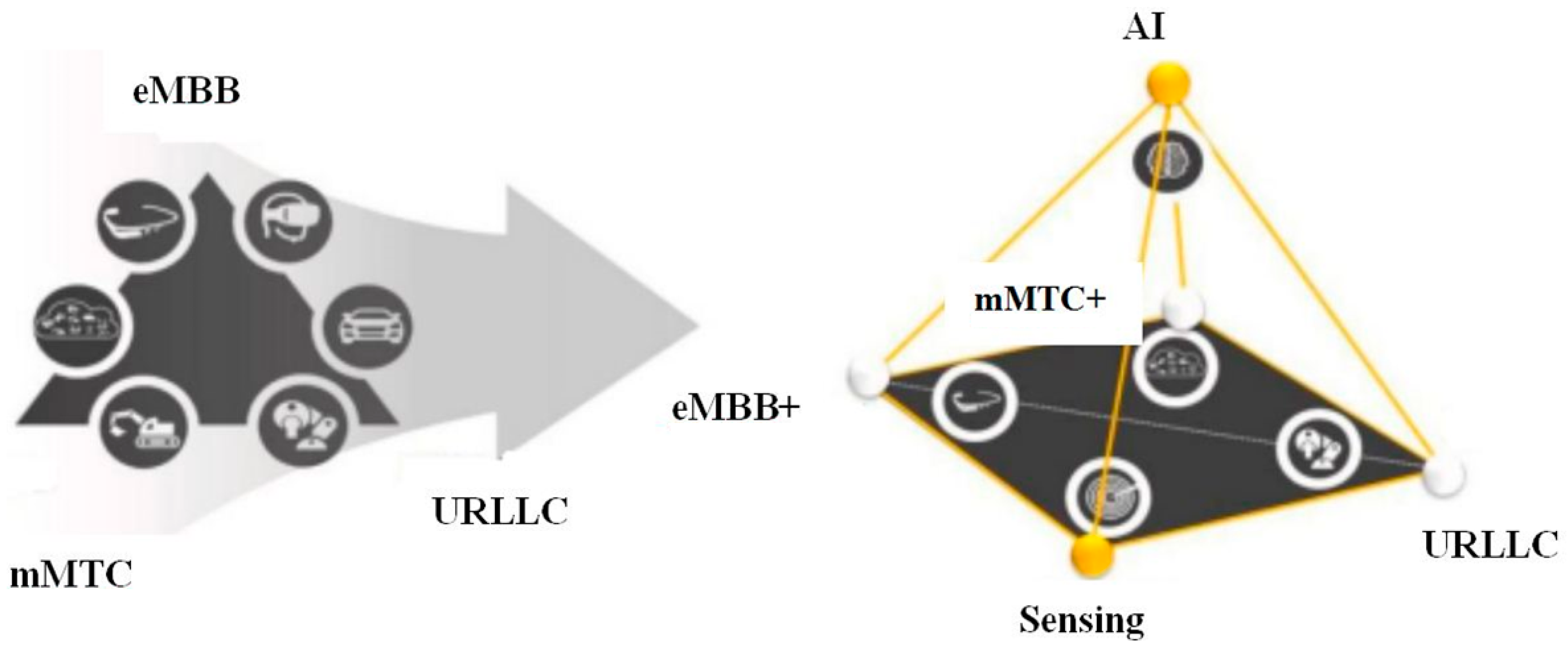
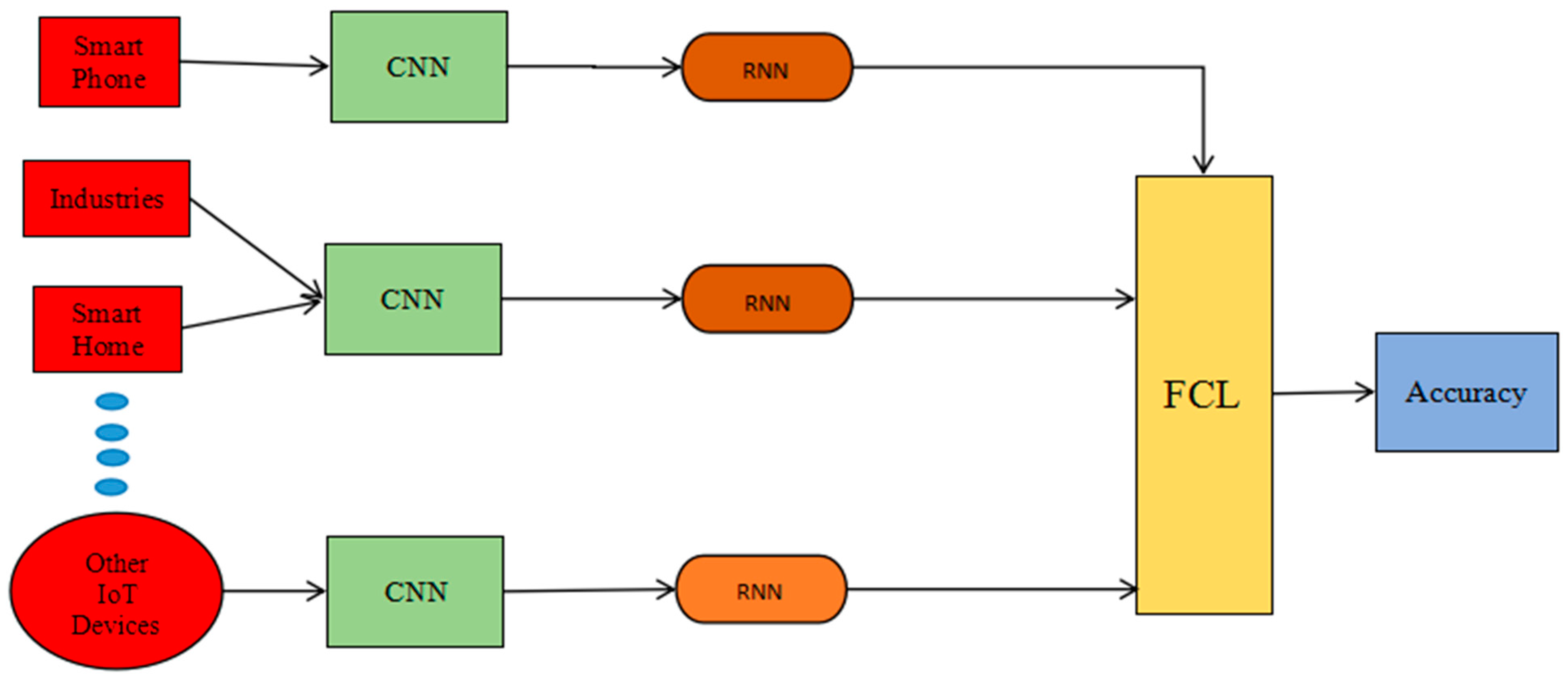
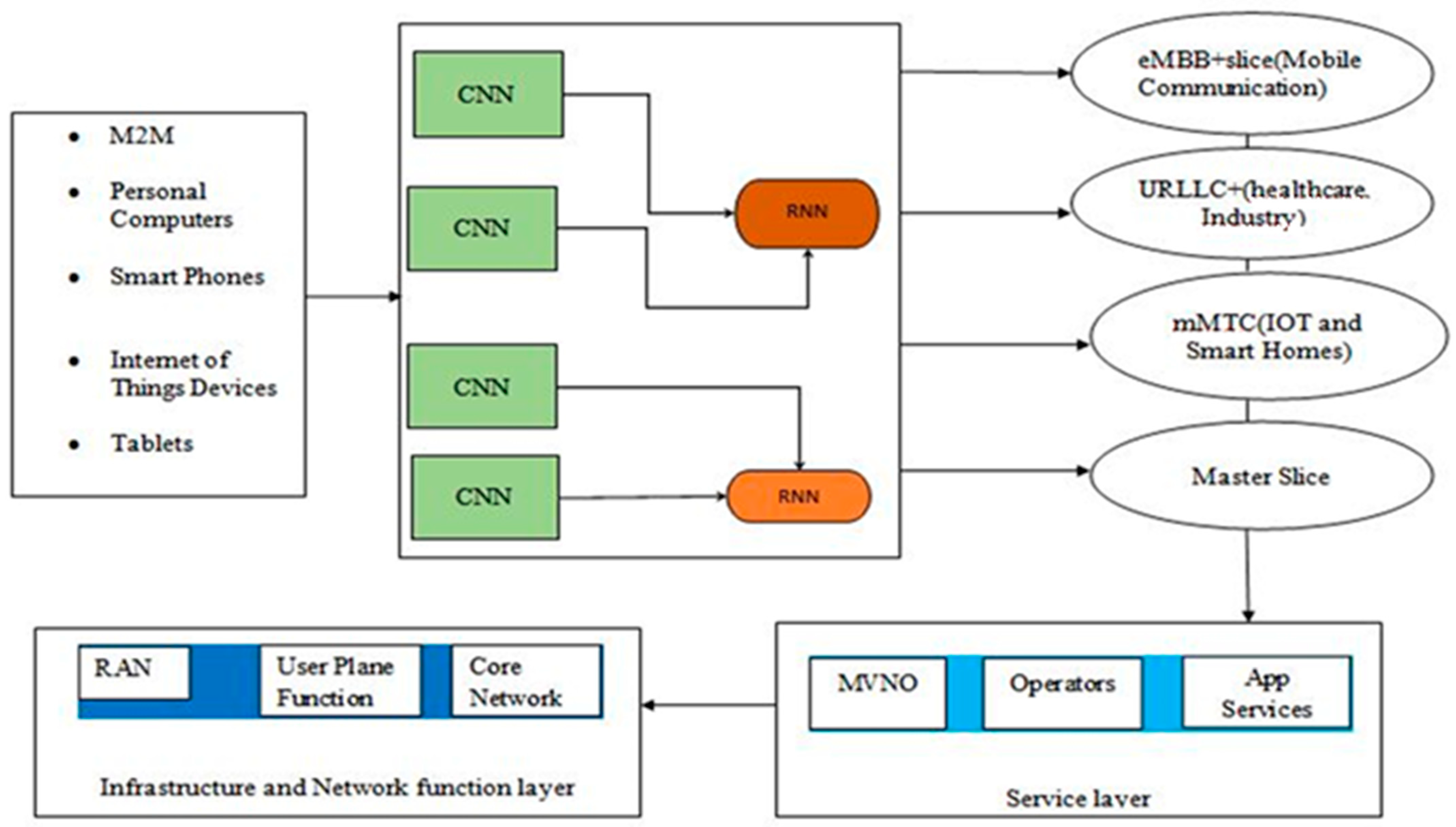
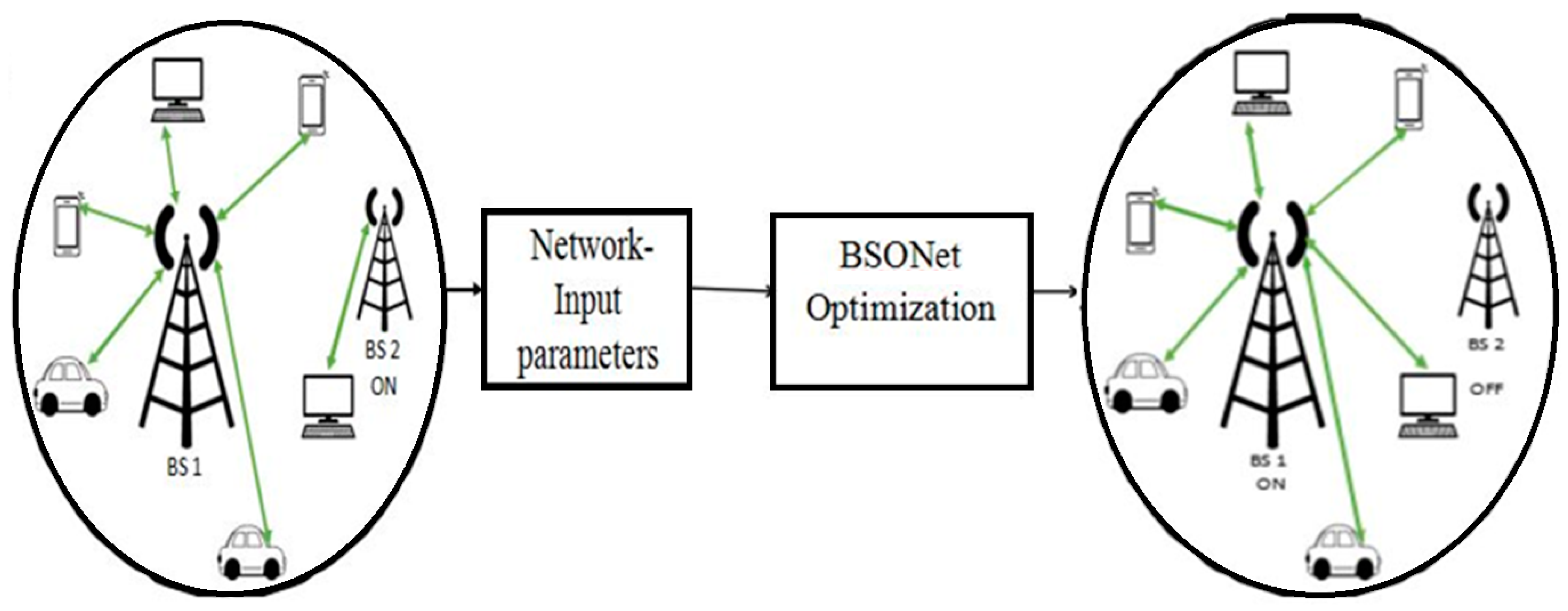
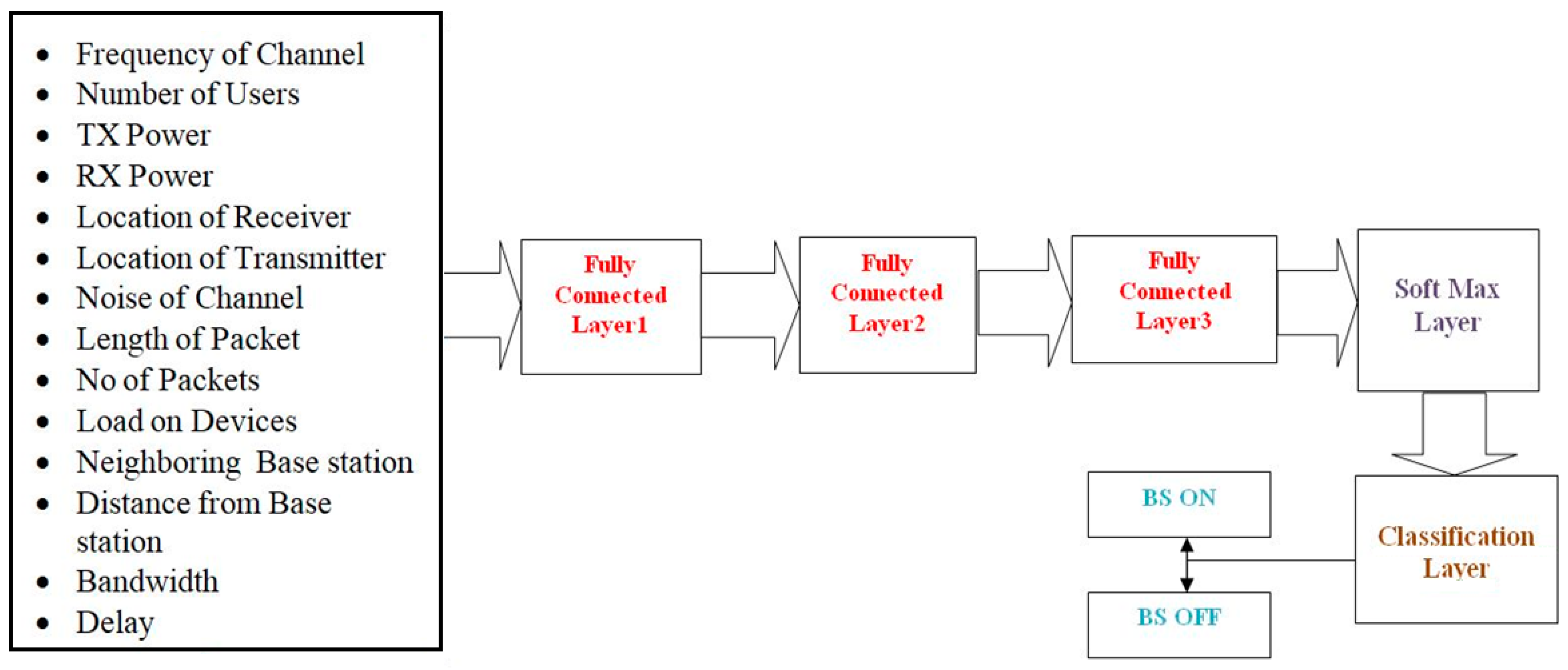
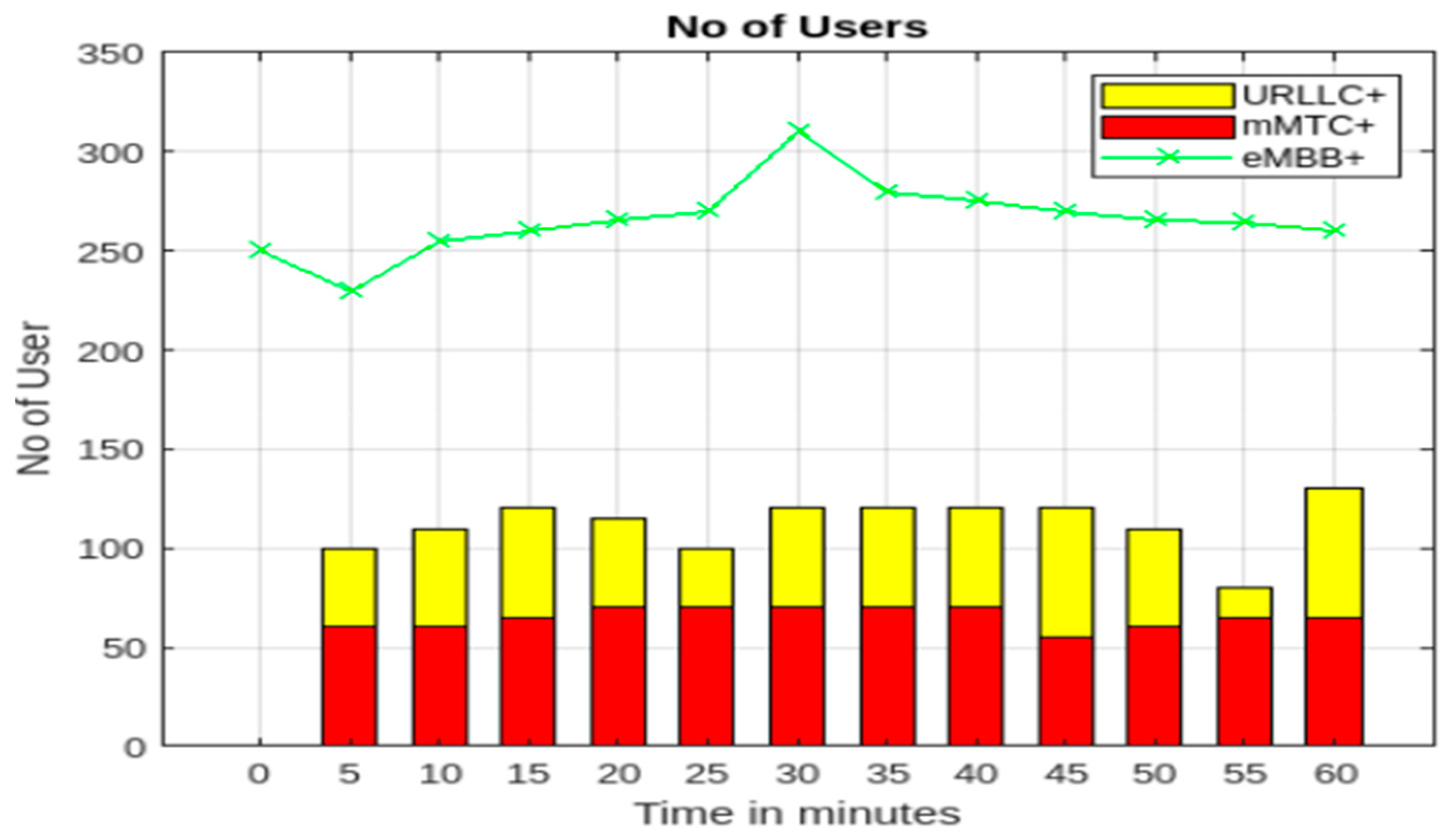

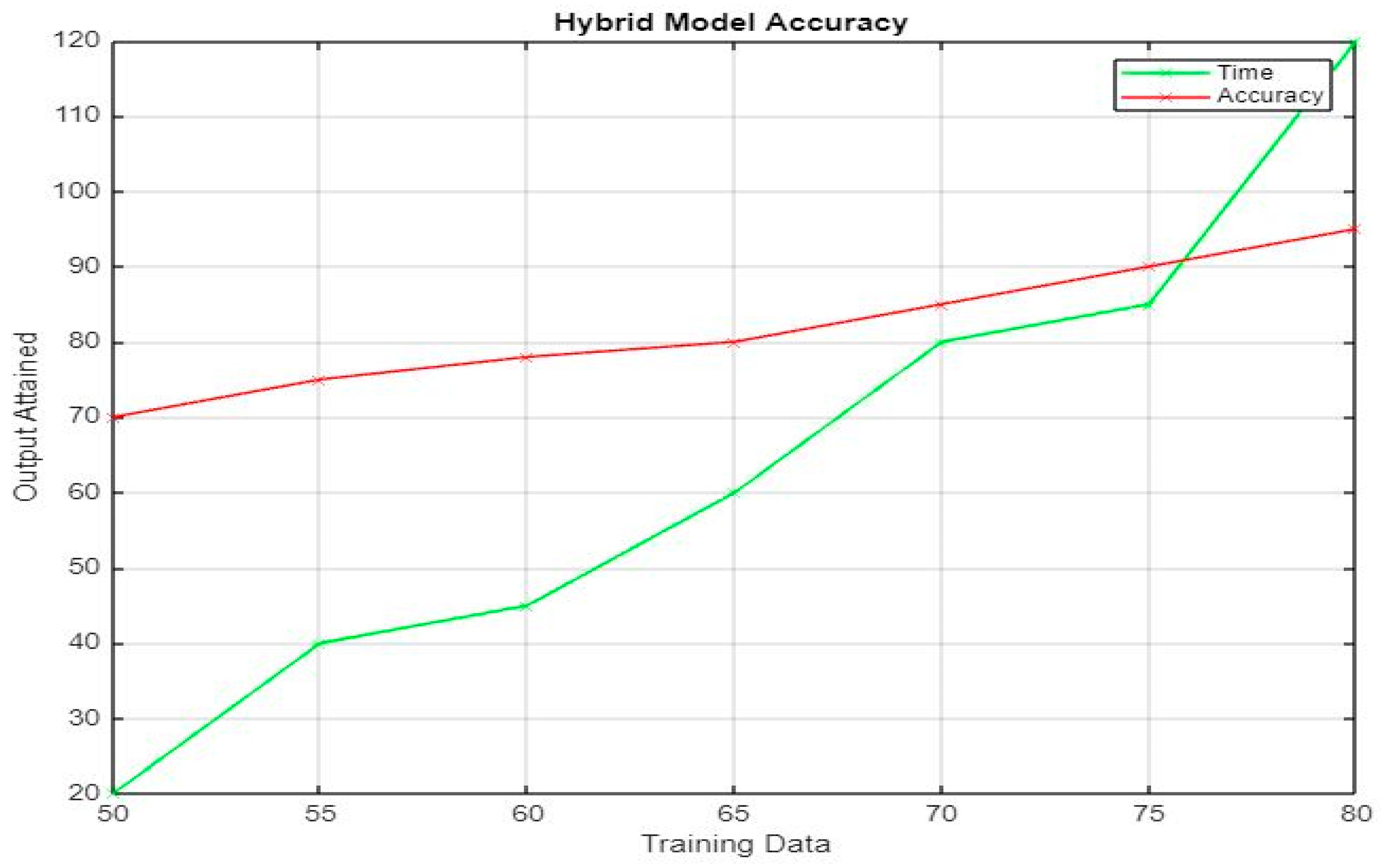
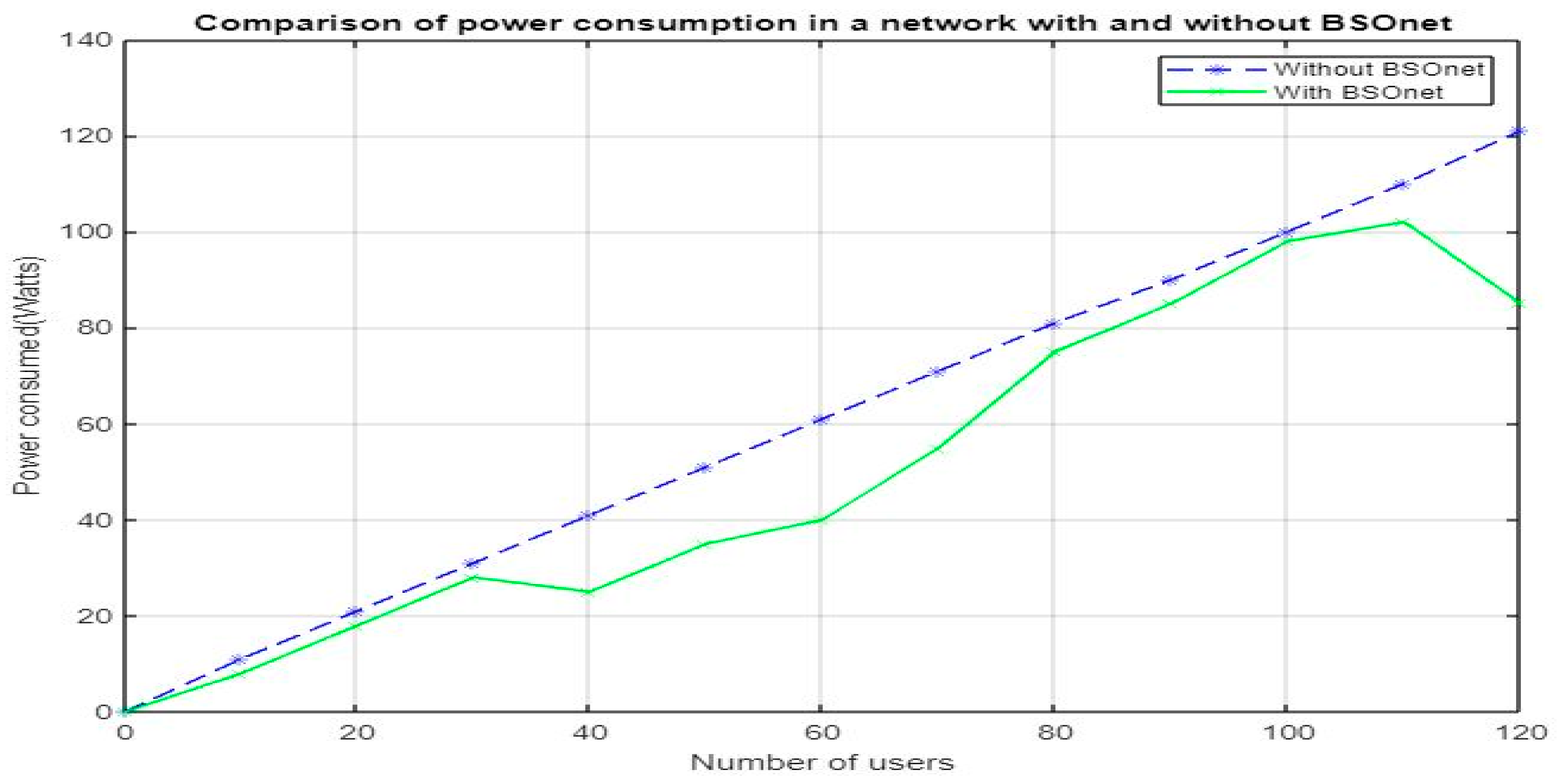
| Base Station ID | Latitude | Longitude | Frequency Band | Power (dBm) | Users Count | Traffic Load (Mbps) | SNR (dB) | Throughput (Mbps) | Interference (dB) |
|---|---|---|---|---|---|---|---|---|---|
| BS001 | 34.0522 | −118.2437 | 3.5 GHz | 40 | 120 | 50 | 30 | 45 | 10 |
| BS002 | 34.0522 | −118.2537 | 28 GHz | 30 | 90 | 35 | 25 | 30 | 15 |
| BS003 | 34.0622 | −118.2437 | 3.5 GHz | 45 | 150 | 70 | 35 | 60 | 8 |
| S. No | Constraint | Value |
|---|---|---|
| 1 | Number of layers | 4 |
| 2 | Number of Hidden layers | 5 |
| 3 | Activation Function | Relu |
| 4 | Metrics performance | Time, accurateness, specificity, F-measurable, correct–incorrect values, variable exercise and assessment sets |
| Metrics | Proposed Model | RNN Model | CNN Model |
|---|---|---|---|
| Accuracy | 98% | 94.5% | 92% |
| Recall | 96.64% | 95.6% | 93.5% |
| Precision | 96.16% | 92.5% | 92% |
| F-Score | 94.76% | 93% | 91.7% |
Disclaimer/Publisher’s Note: The statements, opinions and data contained in all publications are solely those of the individual author(s) and contributor(s) and not of MDPI and/or the editor(s). MDPI and/or the editor(s) disclaim responsibility for any injury to people or property resulting from any ideas, methods, instructions or products referred to in the content. |
© 2024 by the authors. Licensee MDPI, Basel, Switzerland. This article is an open access article distributed under the terms and conditions of the Creative Commons Attribution (CC BY) license (https://creativecommons.org/licenses/by/4.0/).
Share and Cite
Suresh, K.; Kannadasan, R.; Joshua, S.V.; Rajasekaran, T.; Alsharif, M.H.; Uthansakul, P.; Uthansakul, M. Sustainable Resource Allocation and Base Station Optimization Using Hybrid Deep Learning Models in 6G Wireless Networks. Sustainability 2024, 16, 7253. https://doi.org/10.3390/su16177253
Suresh K, Kannadasan R, Joshua SV, Rajasekaran T, Alsharif MH, Uthansakul P, Uthansakul M. Sustainable Resource Allocation and Base Station Optimization Using Hybrid Deep Learning Models in 6G Wireless Networks. Sustainability. 2024; 16(17):7253. https://doi.org/10.3390/su16177253
Chicago/Turabian StyleSuresh, Krishnamoorthy, Raju Kannadasan, Stanley Vinson Joshua, Thangaraj Rajasekaran, Mohammed H. Alsharif, Peerapong Uthansakul, and Monthippa Uthansakul. 2024. "Sustainable Resource Allocation and Base Station Optimization Using Hybrid Deep Learning Models in 6G Wireless Networks" Sustainability 16, no. 17: 7253. https://doi.org/10.3390/su16177253
APA StyleSuresh, K., Kannadasan, R., Joshua, S. V., Rajasekaran, T., Alsharif, M. H., Uthansakul, P., & Uthansakul, M. (2024). Sustainable Resource Allocation and Base Station Optimization Using Hybrid Deep Learning Models in 6G Wireless Networks. Sustainability, 16(17), 7253. https://doi.org/10.3390/su16177253








